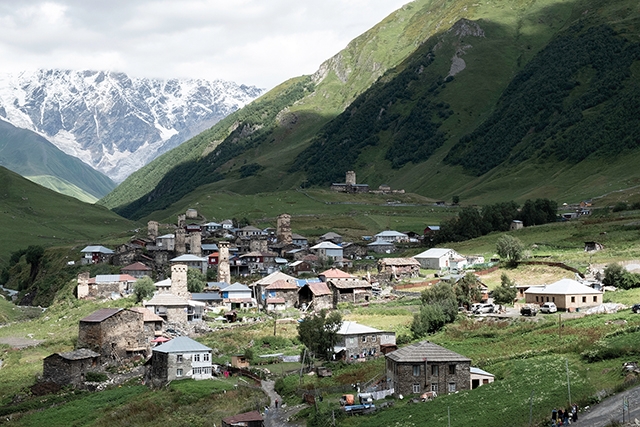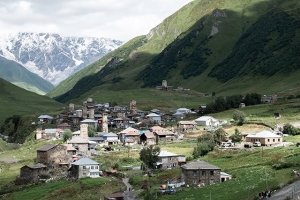Fridon Nizharadze - Painter of the Traumas of Svaneti & the World
The tower buildings of the village community of Ushguli in Svaneti are probably the most frequently photographed motif in Georgia. Ushguli is the longed-for destination of many visitors to Georgia. They want to see the place with their own eyes about which it is often written that it has been preserved on the edge of time. In Georgia, too, it can be heard time and again that life in Ushguli, especially in winter, is like in a fairy tale. The village community is considered to be one of the highest, permanently populated places in Europe (2200m). In the language of the Svans, 'Ushguli' means brave or fighting heart: this tells us a lot about the villagers of Ushguli who live in the mountains all year round.
At the very top of Ushguli resides one of the living icons of Ushguli: Fridon Nizharadze, a painter of elusive style, who only last year had the first exhibition of his life and whose paintings immediately gained admission to the Georgian National Museum.
Nizharadze is one of those extraordinary people who represent the many fractures of 20th century Europe in a particular way. Growing up in Ushguli, once one of the most inaccessible places in the Southern Caucasus, he experienced on the one hand a world shaped by deep traditional orientations and on the other, he experienced what it meant to be catapulted into modernity as an entire community by the Soviet colonization. This sudden emergence of modernity in Svaneti enabled him to study painting at the Academy of Fine Arts in Tbilisi. He brought a Svaneti XY with him which was characterized by traditional values and a great attachment to nature. He carried this Svaneti with him in his whole body, in his entire being. In Tbilisi, he met the expectations of socialist realism, which he contrasted with his Svan love of nature and its mythical roots. The artist then began to detach himself from the promises of Soviet modernity when he first began to understand and then denounce Stalin's crimes.
The violence which then happened to him shaped his whole life. His pictorial work has an enormous contemporary significance: equally against the background of a rapidly advancing tourist transformation of the mountainous Georgian region, as well as against the current attempts of the Russian president to reinterpret Stalinism.
His house is the last one on the hillside. Above it, there is only the chapel with the icon of St. George, a little further on, the monastery Lamaria can be found.
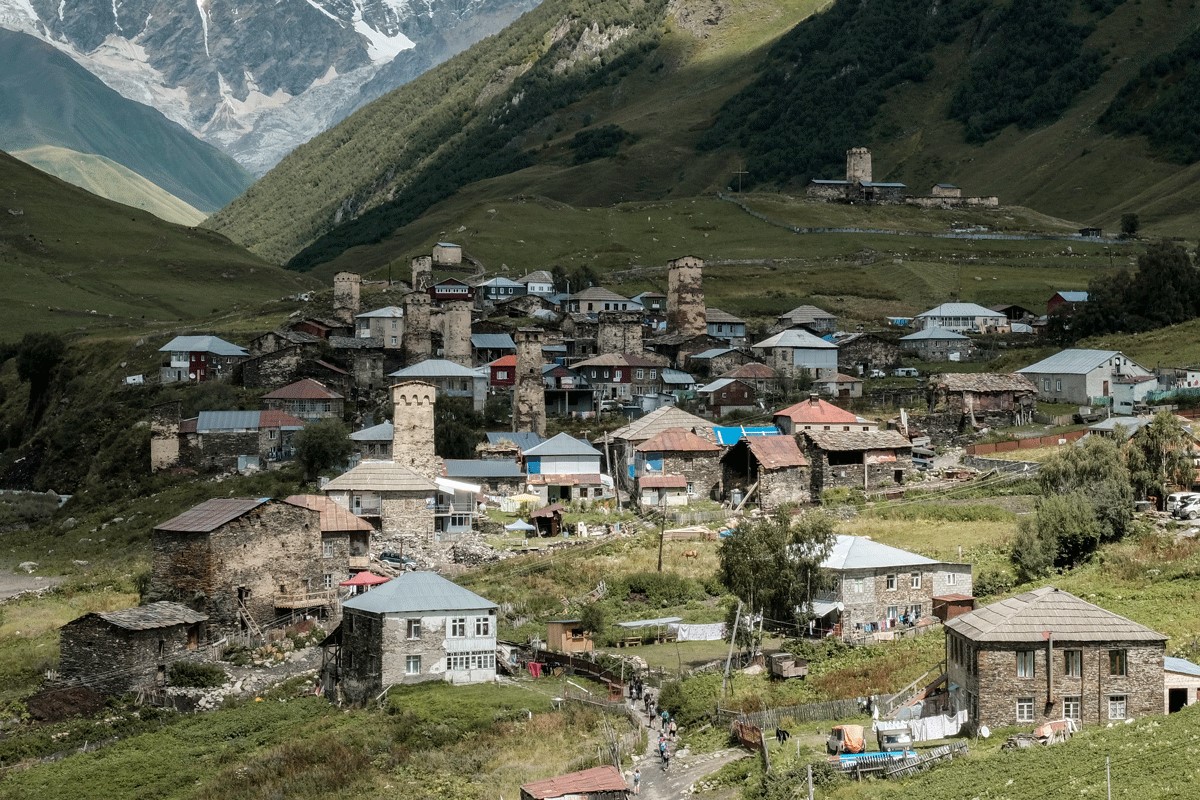
Getting to Fridon is easy because everyone knows him in Ushguli. Talking about him doesn't seem to be easy for everyone, though. Young people, who only spend the summer in the village community because of the tourists, only have a few catchwords about the strange painter to hand. Older people express themselves rather reservedly, hesitantly, almost cryptically. And when they have said something, you might almost have the impression that they want to take back their words immediately.
They say there is not a single book he hasn't read. They say he is the smartest person in Ushguli. So very wise! And they raise their hands and wave far into the distance to show that they are not in a position to judge. “You have nothing but potatoes in your head!” This is how he speaks to the people of Ushguli, they say. And they whisper that he cannot know what proper/real work is after all. Because what he does is not work: a momentary fright. You say nothing unpleasant about others/fellow Ushguli people in Ushguli. Who can know where this might lead? People are just different.
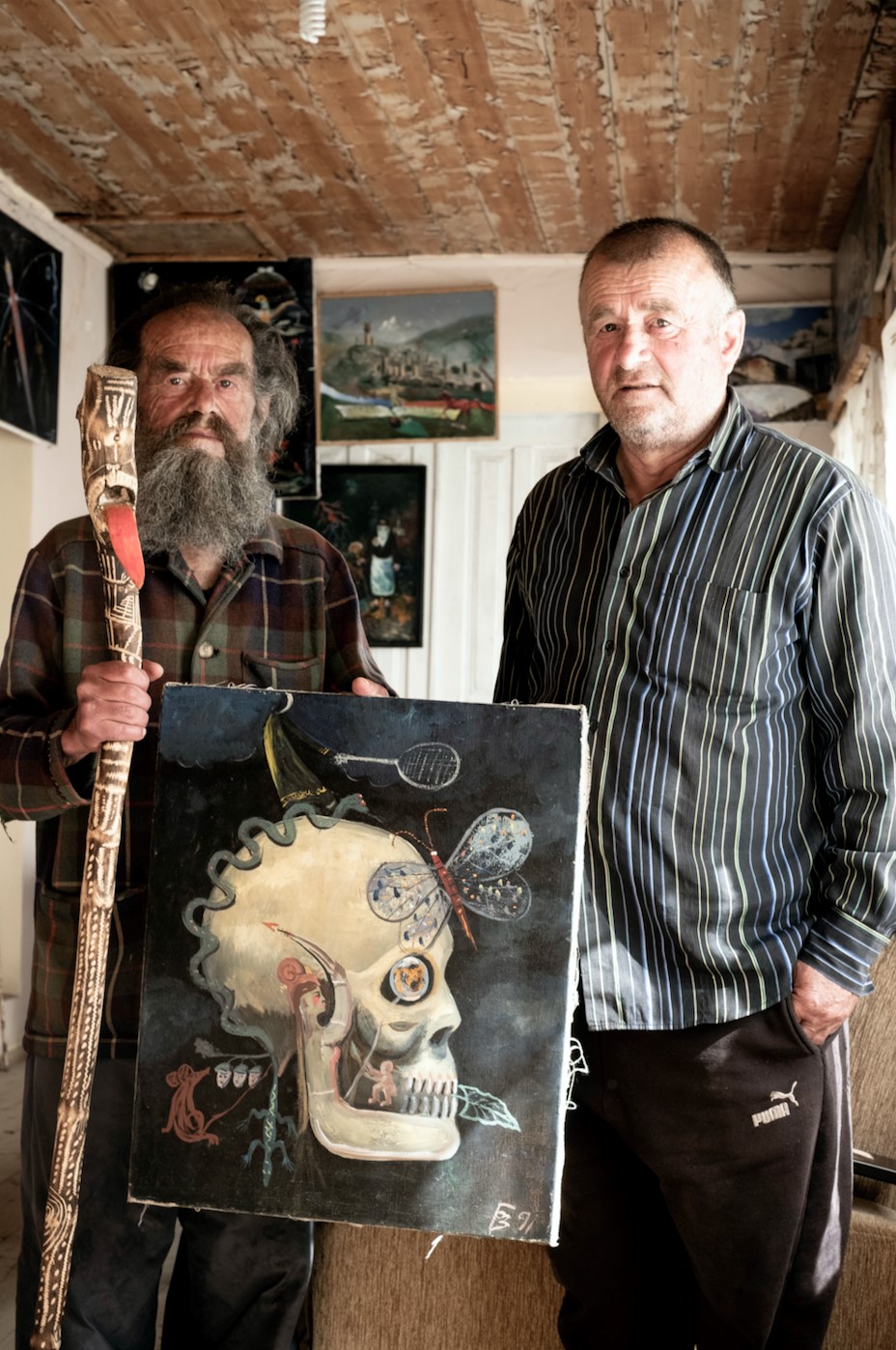
The younger brother acts as Fridon's wall against the outer world, as a translator between the world of the older brother and that of the others. Temraz is the down-to-earth person, the agronomist, the last steward of the potatoes, cows and pigs in Ushguli and as well of the reluctance of its inhabitants. Fridon is the one who, as a child drew with everything he could grab: with stones on wood, with charred pieces of branches on snow, often wild and angry and unworldly.
“Come back tomorrow,” Temraz said, when I first met him. “Fridon just got back from the hospital yesterday. He needs some rest.” I left and came back the next morning, wondering if Fridon might like to show and explain his pictures? “Of course, three Lari!” he said, facing me with severe eyes. “Come in.”
His pictures are dualistic and anti-realistic, he explains. He learned nothing in Tbilisi, where they tried to force him into socialist realism. Van Gogh had schizophrenia, he exclaims. He also had schizophrenia. He was diagnosed in 1973 when they held him in a psychiatric hospital.
Many liters of blood were taken from him that month, again and again, he says. His temperature was so high that they had to get him out of bed at night to give him cold radiation. Thirty-eight times this happened, at all times of the day, the nurses were suddenly there and put him in a tiled room until he collapsed.
“When he was locked up, we visited him in Tbilisi,” the brother explained. “We didn’t understand him either. Fridon, we said, nobody understands your pictures! Can't you paint things as they are? We asked him sincerely because we were worried. But, you know, he's stubborn.”
He is challenging to grasp, even less to understand. He speaks at high speed, leaves no time to react on the words he throws at the listener: he asks, explains, throws out sentence after sentence, full of references to politics, literature, myth: Do you know Shevardnadze? Do you know what Dostoyevsky wrote? Have you read about Medea? He grabs the carving stick representing Chaplin, pushed the bat called Einstein aside and points to the pictures, never touching one with its tip, explaining every element. From a great height, he takes everything down on shaky stairs, balancing it. It is not necessary to help him.
He jumps from one picture to the next and back, confronts the listener, looks, changes, asks questions over and over again and testifies.

The images are destructive. The world is out of joint, without any sense in itself: a crazy world bent on destruction. Fridon then gives the madness an interpretation of clear symbols and contexts. He is Laocoon in the psychiatric ward, embraced by the python of state power. He is caught in handcuffs when the Soviet Empire destroys young Georgia: the Bolsheviks have uprooted the tree from which the fresh leaf has grown.
He tries to capture a crazy world with his pictures. Mad from the madness of great destruction: Stalin and Hitler, again and again, Communism and National Socialism as equal variants of the same inhumanities.
The dualistic pictures have high prices because they are two pictures in one, he explains, costing once 37 billion Swiss francs, once 27 million. The destruction of the world by Stalin and Hitler costs 50 million dollars because 50 million people died.
“We used to sell paintings to tourists at $10 apiece. We don't do that anymore. We keep all his paintings with us,” Temraz says.
The path of Homo Sapiens is a path of bones. It ends in a rocket that unleashes a mushroom cloud that will destroy the world. At its end is the cross. The Georgian archangel wears a Svan cap and looks stunned at the world in which Hitler and Stalin rage.
And yet: Georgia will survive because its inhabitants are capable of living in harmony with nature, supported by traditions that survive everything.
What brought him to the psychiatric ward? Otherness, or criticism of the system?
The next morning, I met the younger brother again. He talked about the hardships of life in the Soviet era. He told me about how they put Fridon in a psychiatric ward after his studies in Tbilisi for his criticism of communism. Others were put in prison as well. Some were murdered. Others went mad over it all.
“We were all ardent Communists back then, you know, including him. At the Academy, he was supposed to paint like the others. He refused. Then he started criticizing Stalin and Lenin.”
Taking blood to weaken, blasting with cold water to break the resistance. Both to affirm a system above everything else.
The Svans in their attempt to save their remote world despite the rage of the influential and misanthropic political powers that govern the course of the world.
What kind of person is this one you find here, high above Ushguli, in the last house on the slope? A painter, until last year without a single exhibition in his life, surrounded by constant outer silence, in persistent inner turmoil. What a strangeness compared to the others, who are also quite alien to each other. How happy must a person be to be allowed to enjoy freedom in seclusion in the end?
“Life is hard up here. In winter, we barely get out of the house for half a year. At the onset of winter, everything you need, you bring indoors. Then the snow comes, and you stay among yourselves. You visit each other at parties, talk, eat and drink. For a painter or philosopher, there can be no better life,” Temraz explained.
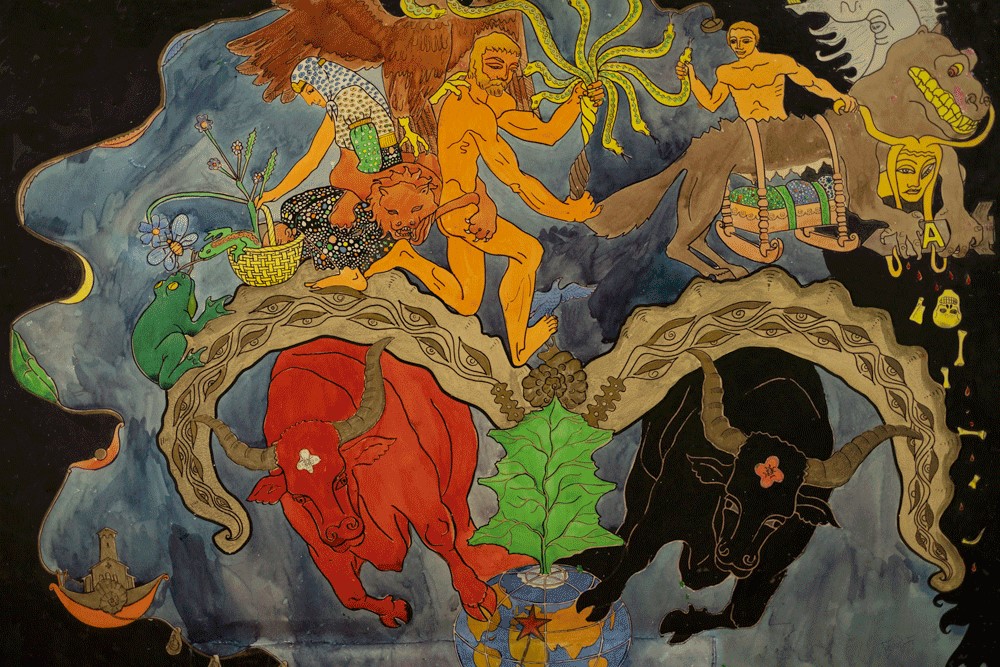
It is the experiences of insecurity, wars of secession, civil wars, banditry, the threat of the outer life, before which everything that follows must appear suitable. The life experience of the people of Ushguli provides an in-depth insight into the social system of life in Svaneti. And it opens up the possibility of discovering the traces that the Soviet system left behind in both material and immaterial space in the region.
By Stefan Applis
